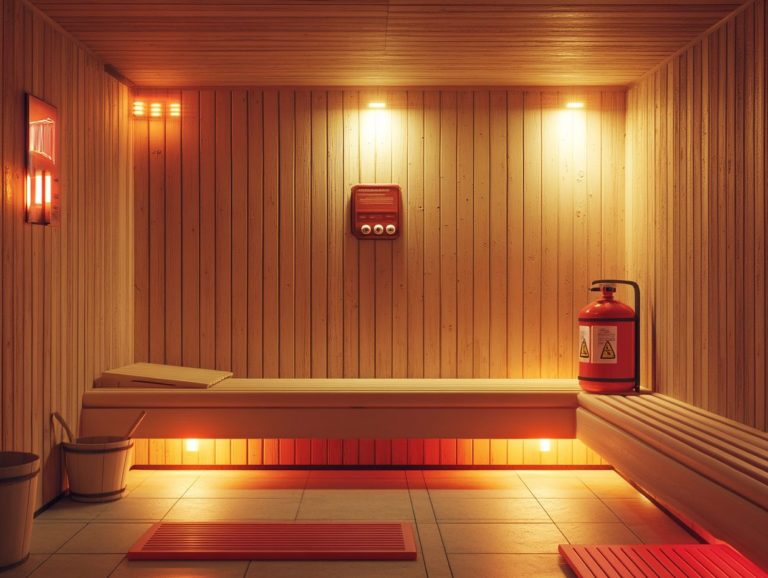Understanding the Role of Heat in Sauna Safety
Saunas provide a distinctive combination of relaxation and health benefits. However, it s crucial for you to understand how heat affects your body before you step inside.
This article delves into how your body reacts to heat, examines potential risks such as heat-related illnesses, and outlines best practices for safe sauna use.
It also highlights precautions for vulnerable populations, ensuring that everyone can enjoy the soothing experience of a sauna without worry.
Embrace the opportunity to learn how to maximize the benefits of your sauna sessions!
Contents
Key Takeaways:

- Saunas can cause heat-related illnesses and injuries if not used safely.
- It’s important to follow recommended guidelines for temperature and duration in the sauna.
- Certain populations, such as children, pregnant women, and elderly individuals, may need to take extra precautions when using a sauna.
What is a Sauna?
A sauna is an inviting haven designed for your relaxation and wellness, deeply rooted in cultures like Turkey and Scandinavia. You ll find various types of saunas, including traditional, infrared, wet, and dry, each offering a distinct experience tailored to your personal preferences.
The North American Sauna Society highlights the importance of understanding these variations so you can fully appreciate the many health benefits that come with regular sauna use.
Traditional saunas, with their rich legacy, often feature wood-burning stoves that create a warm, welcoming atmosphere ideal for socializing. In contrast, infrared saunas use infrared heaters to penetrate the skin more deeply, delivering a therapeutic experience that many enthusiasts swear by.
Wet saunas, often synonymous with steam rooms, foster a high-humidity environment that can ease respiratory concerns. Meanwhile, dry saunas deliver an intense heat without the moisture.
Whether you re enjoying the communal bathhouses of Finland or the tranquil hammams of Turkey, the act of sweating not only helps you unwind but also promotes detoxification and improved circulation. Clearly, saunas are an essential element of holistic health that you shouldn’t overlook.
How Heat Affects the Body
Heat exposure during your sauna sessions triggers a series of physiological changes in your body, encouraging sweating and enhancing cardiovascular health. When practiced safely and in accordance with guidelines from reputable health authorities like the World Health Organization, these sessions can offer notable benefits.
You must understand the implications of heat stress and the potential risks of heat-related illnesses.
Physiological Responses to Heat
When you re exposed to heat, your body kicks into action with a series of physiological responses. This includes increased sweating and the production of heat shock proteins, both of which can enhance cardiovascular function and potentially lower the risks associated with cardiovascular disease just as experts like Dr. Rhonda Patrick have pointed out.
These mechanisms are crucial not just for regulating your temperature but also for maintaining your overall health. Sweating cools you down while promoting skin hydration and electrolyte balance. Simultaneously, heat shock proteins play a protective role, repairing damaged proteins and supporting cellular function.
Research indicates that consistent exposure to heat can lead to adaptations that improve endurance and cardiovascular efficiency, contributing significantly to your long-term well-being. By incorporating heat acclimation practices, such as spending time in a sauna, you might also bolster your mental resilience and promote recovery. It’s essential to be aware of sauna safety legislation to ensure these responses are essential parts of a holistic health regimen that you won’t want to overlook.
Potential Dangers of Sauna Use

While saunas offer a wealth of health benefits, they also come with potential risks, such as heat-related illnesses like heat exhaustion and heat stroke. Make sure you follow safety tips to enjoy your sauna experience to the fullest!
Prioritizing your well-being in this relaxing environment is key to fully enjoying the experience.
Don t wait! Learn how to safely enjoy all the benefits that saunas offer today!
Start your journey to relaxation and health by learning the best practices for sauna use!
Heat-Related Illnesses and Injuries
Heat-related illnesses like heat exhaustion and heat stroke can sneak up on you during sauna sessions if you don t take the right precautions. Research by Kinnunen A and Hannuksela-Svahn A underscores the importance of being aware of the signs and implementing preventive measures to protect yourself.
Pay attention! You might experience symptoms such as headaches, dizziness, muscle cramps, and nausea. These are clear signals that your body is struggling to manage its core temperature.
Be extra careful if you have existing health conditions, particularly heart problems. Staying properly hydrated and being mindful of how long you stay in the heat can make a world of difference.
Talking about sauna safety helps recognize personal limits and create a more secure environment for everyone involved.
Best Practices for Safe Sauna Use
To ensure a positive and safe sauna experience, you must adhere to best practices that encompass proper temperature control and consistent hydration.
By following these guidelines, you can significantly enhance the health benefits associated with sauna use.
Guidelines for Sauna Temperature and Duration
Regarding sauna temperature and duration, always adjust the heat levels based on your own comfort and safety.
This way, you can fully enjoy the therapeutic benefits of sauna therapy without compromising your health.
Different types of saunas, including traditional Finnish, infrared, and steam, typically recommend specific temperature ranges. Traditional saunas usually operate between 150 F to 195 F (65 C to 90 C), while infrared saunas tend to be set at lower temperatures, around 120 F to 150 F (49 C to 65 C).
As for session duration, most people find that 15 to 30 minutes per visit is ideal. Your personal preference plays a significant role; you might lean towards longer sessions for deeper relaxation or prefer shorter visits to avoid overheating.
Understanding these nuances can significantly enhance your enjoyment and safety during each sauna session.
Precautions for Specific Populations

Certain groups, such as children, pregnant women, and the elderly, require specific precautions when using saunas. Their heightened vulnerability to heat-related health risks underscores the importance of implementing tailored safety measures.
Considerations for Children, Pregnant Women, and Elderly Individuals
When it comes to sauna use for these groups, adapting standard practices is essential to ensure safety.
For children, keep sessions short ideally around 5 to 10 minutes and maintain a lower temperature range of 150 F to 160 F to minimize discomfort. If you are pregnant, it’s best to avoid the sauna during the first trimester. If you decide to indulge later on, limit your time to 10 to 15 minutes at a moderate heat level of 160 F to 170 F. Additionally, understanding the role of ventilation in sauna safety is crucial for a safe experience.
Elderly individuals should also restrict their time to 5 to 10 minutes, with a comfortable temperature setting around 150 F. This helps protect against potential cardiovascular strain and dehydration.
By adhering to these guidelines, you can foster a safe and enjoyable sauna experience for everyone involved.
Frequently Asked Questions
What is the role of heat in sauna safety?
Heat in a sauna helps you relax, detoxify, and improves circulation. But remember, too much heat can lead to dehydration and health risks, so stick to safety guidelines!
How does heat affect the body in a sauna?

Heat in the sauna makes you sweat. Sweating cools your body and can help remove toxins.
However, too much heat can lead to fatigue and dehydration. Listen to your body and take breaks as needed.
What are the potential risks of excessive heat in a sauna?
Too much heat can cause dehydration and dizziness. In extreme cases, it may lead to heat stroke.
People with heart problems should be extra cautious. Always monitor how you feel in the heat.
How long should a person stay in a sauna?
Generally, limit your sauna sessions to 15-20 minutes. If you feel uncomfortable, take a break.
Stay hydrated by drinking water before, during, and after your session. Your body will thank you!
Are there any safety precautions to take when using a sauna?
Yes, stay hydrated and limit your time in the sauna. Avoid alcohol and drugs beforehand.
Follow proper sauna etiquette. If you feel ill, it s best to sit this one out.
Can pregnant women use a sauna?
Pregnant women should skip the sauna. High temperatures can harm the developing fetus.
Consult your doctor if you have any existing health issues. It’s better to be safe when it comes to sauna use.






